hankyoreh
Links to other country sites 다른 나라 사이트 링크
[Korea travels] Spring is in the air in Donghae, where ocean vistas take your breath away

After the fires raged, spring returned.
On March 25, I found myself on Nongoldam-gil, a street in the Mukhojin neighborhood of Donghae, Gangwon Province. The hill that rises from Mukho Port is dotted with colorful houses. The narrow lanes winding up the steep hill are sprinkled with plum blossoms and cornelian cherry blossoms.
At the top of a nearby hill, I could see burned-out shells of buildings — some homes, some guesthouses — where workers were busy clearing away the rubble.
The forest fire that had begun in the Okgye township of Gangneung had spread here, fanned by powerful winds The forest fire caused the city of Donghae 17.3 billion won in damage, with it losing more than 180 buildings and 2,735 hectares of woodlands, which amounted to 20% of the city’s total wooded area.

Donghae is a port city of some 90,000 people on the East Sea, near the southern boundary of Gangwon Province.
The city’s history doesn’t go back very far. It was created through the union of the Mukho township, in Myeongju County, and the Bukpyeong township, in Samcheok County, both parts of Gangwon Province, in 1980. The port in Mukho was the center of the fledgling city.
Built in 1941, the port was a forward base for fishermen on the east coast, as well as Korea’s main port for exporting cement and anthracite, also called hard coal. Fishing boats heavy-laden with pollack and squid congregated at the port, fueling commerce.
As Korea’s coal industry faded and fishing hauls declined in the 1980s, the towns around Mukho Port stagnated. But in 2010, a fresh breeze was blowing in Nongoldam-gil (which is the name both of the street and the surrounding neighborhood around the port’s lighthouse). That was when the Donghae Cultural Center and area residents started painting murals about the neighborhood’s history on its side streets.
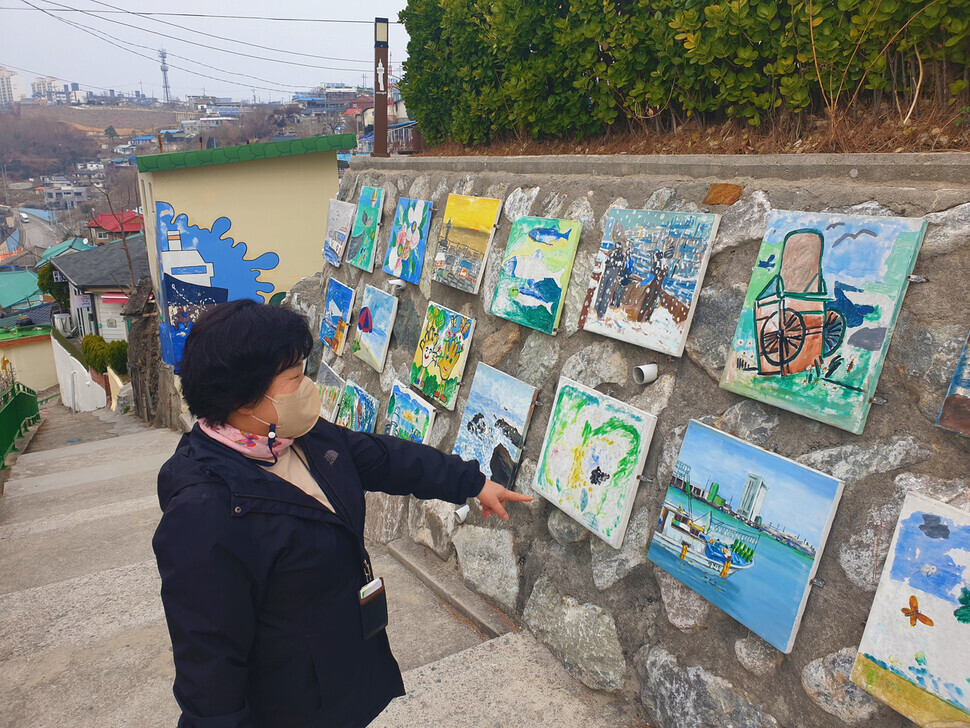
Nongoldam-gil had been reborn as a neighborhood that stood out for its art and culture.
Today, the neighborhood’s murals — as well as views of the port and the East Sea beyond it — make it a popular attraction in the city of Donghae. In particular, the cramped side streets that creep up the slope of the hill are a joy to explore.
Travelers to Nongoldam-gil have their pick of four paths, including Nongol 1-gil and Deungdaeoreum-gil, meaning “path up to the lighthouse,” which offers a view of the murals documenting the history of the port and the lives of its residents.
“Just as they say all roads lead to Rome, all the paths here lead up to the lighthouse,” said Lee Hye-yeong, a Donghae tour guide.
Lee told me that if you follow the path to the lighthouse at the top of the hill, you’ll get an expansive view of the East Sea.
Each day, the ocean presents itself in three different guises. There’s sunrise in the morning; the ocean blue in the daytime; and the glitter of fishing boats at night.
Travelers are also bound to be enchanted by the murals lining the roads, depicting squid on the line, people preparing sashimi, and children playing the traditional “squid game.”
Lee directed me to a wooden plaque engraved with a poem titled “Hill of the Wind,” author unknown. The poem, she said, was an accurate portrayal of the lives of the townspeople and the harsh storms that buffeted them.
They laid their lives down before the wind,
The wind that had swallowed fathers and husbands
before blowing again over Mukho Hill
to dry the squid and pollack hanging there,
giving life to those who remain.
For them, that wind is life, death,
and a whisper of hope for a better life.
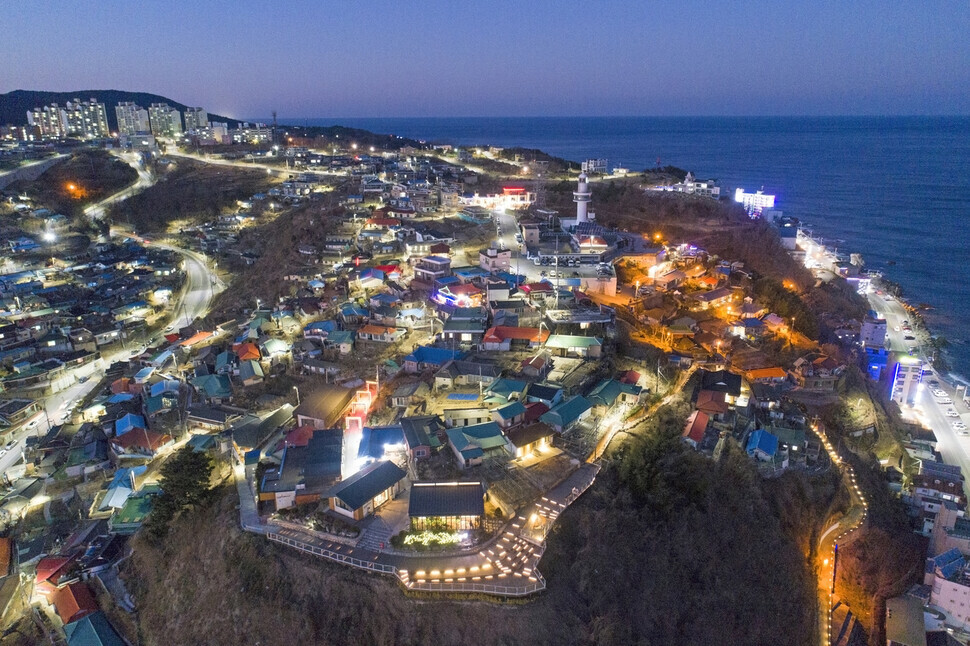
The neighborhood has built a new attraction for tourists: Dojjaebigol Sky Valley. The name Dojjaebigol, which means “goblin valley,” derives from an old legend about bluish will-o’-the-wisps that could be seen in a cemetery there in the spring rain.
Along with the 59-meter-high sky walkway, with its view of the ocean, there is the sky cycle suspended bicycles in the air along wires, and a giant slide that sends you rushing 27 meters down a cylindrical chute.
Down below is the Haerang Observatory, a walkway that extends 85 meters into the ocean. Some sections of the walkway feature glass flooring, making it look as if you’re walking on water. At night, the entire walkway is lit up, making it a popular spot to take photographs.
Another place worth visiting is the observatory in Byeolbit (Starlight) Village, next to Nongoldam-gil. Byeolbit Village is on the hill across from the parking lot for Mukho’s ferry terminal. Built in November 2021, the observatory here is little known, even though it offers a fantastic view of the sea. Below the observatory is a photo spot beside a sculpture of the Little Prince, which has come to symbolize the neighborhood.
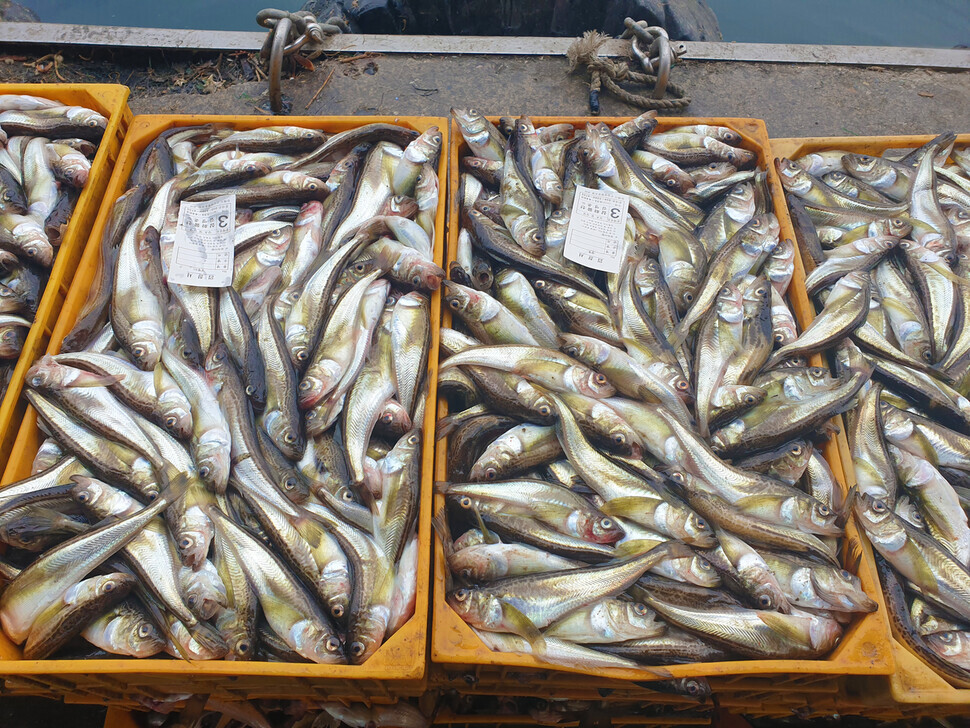
On my visit, I met 88-year-old Lee Geum-ja, a resident of Byeolbit Village. Lee told me she sweeps the benches at the observatory in front of her house each day — a volunteer cleaning service she took up of her own volition.
“People haven’t been coming since the fires, but I still clean the observatory every day. The stairs are steep, but if you climb up here, you can see the ocean and the ships going by. It’s a great way to blow off some steam.”
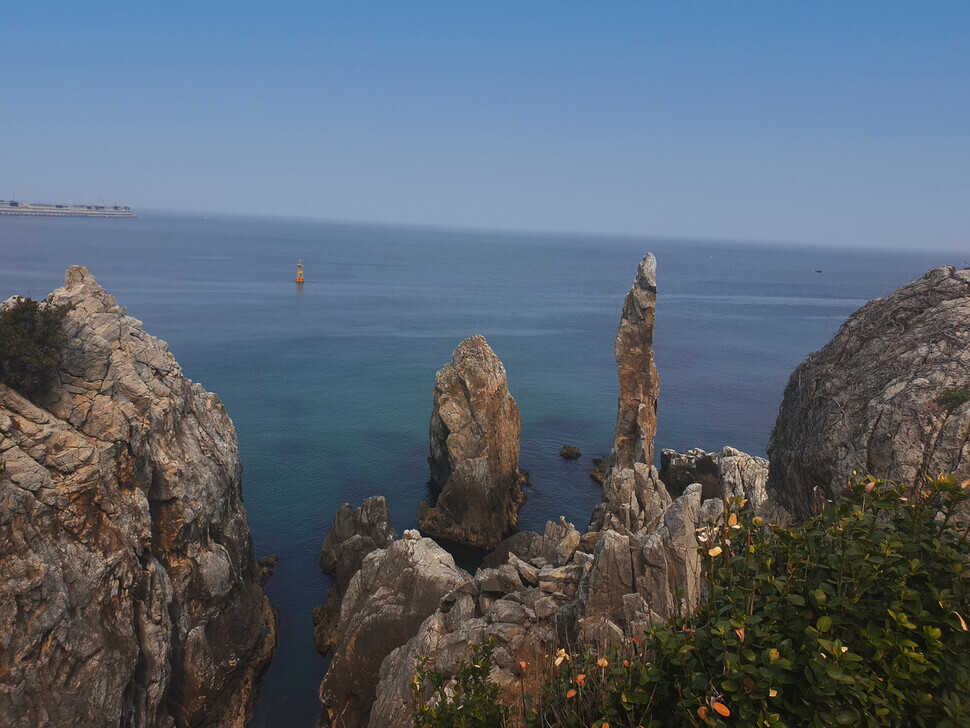
There are two seaside walking paths in Donghae with views of the ocean: Course No. 33 and Course No. 34 on Haeparang-gil (With the Waves Path). Course No. 33 runs from Chuam Beach to Mukho Station (13.3km, 4.5 hours), and Course No. 34 runs from Mukho Station to Gangneung Okgye Market (18.9km, 6.5 hours).
Course No. 33 is particularly charming, passing by a string of small but splendid beaches off the beaten path — Gamchu, Hanseom, Gobulgae, and Hapyeong, among others. This path offers some nice spots to pause and gaze out at the crashing waves.
I hit the trail on Course No. 33, which begins at Chuam Beach. Along with being a popular place for viewing the sunrise, this is the site of Chotdaebawi (Candlestick Rock), which juts up from the ocean.
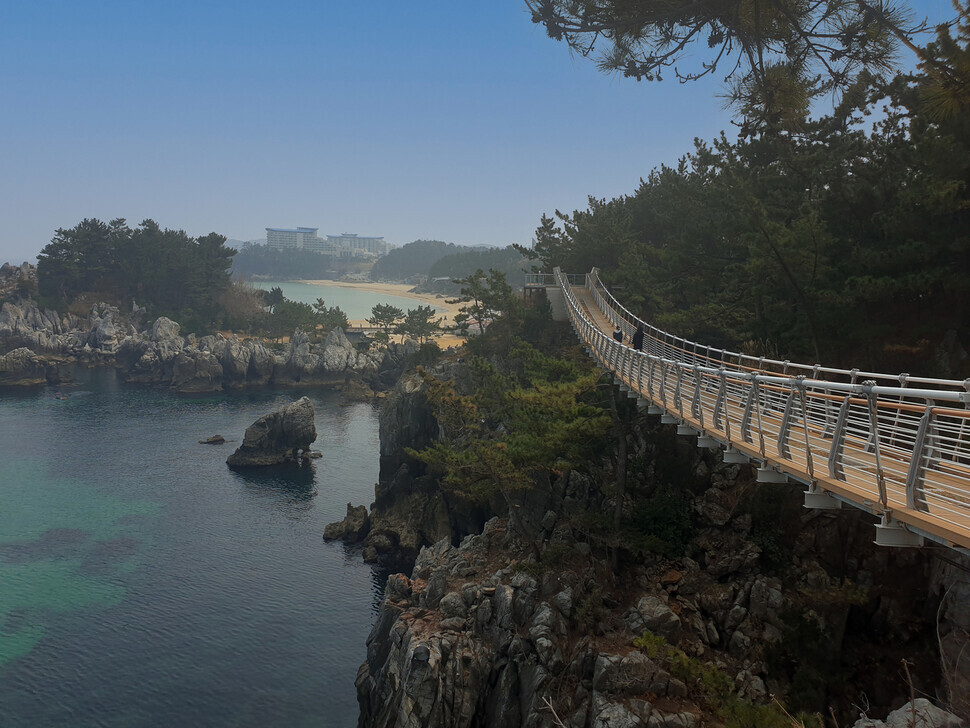
There are a number of strange and striking rock formations in the area. Following the path along the coast, hikers come upon a 72-meter-long suspension bridge over the water. There are gaps in the bridge that give a glimpse of the blue water and fish below. And on either side of the bridge are observation decks that look down on the clear blue waters of the East Sea.
Moving on from Chuam Beach, you pass Donghae Station and reach cozy Hanseom Beach. As the closest beach to the Cheongok neighborhood, this is the locals’ favorite place to go for walks. Because the beach is so small, you can view the whole expanse at once, along with the curiously shaped rocks and a lush grove of pine trees hugging the coast.
Recently, word has been spreading about the photogenic qualities of the Hanseom “light tunnel,” where you can snap a daytime selfie with the sea and sky behind you.
From Hanseom Beach, it’s about a 20-minute walk to Gobulgae Beach, where there are more fascinating rock formations to see. The curious rocks on this beach come in a variety of colors and shapes weathered by the waves.
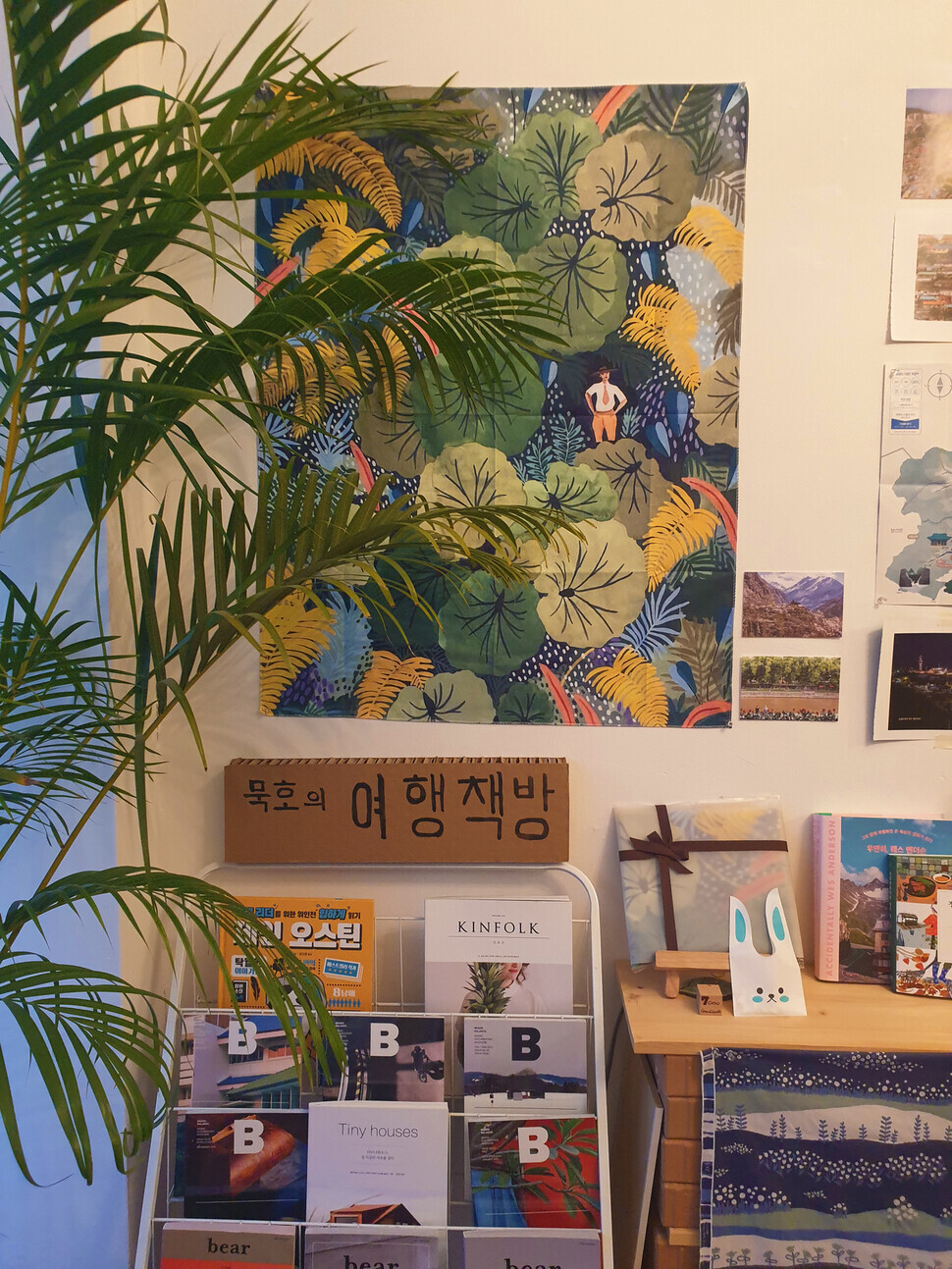
The geological phenomena that are visible here are the product of wind erosion over millennia. It’s also fascinating to see the seaweed and moss growing between the rocks. I was told that in the summer, tiny crabs also populate the cracks in the rocks.
“I recommend that visitors to Donghae hike on Haeparang Course No. 33,” said Chae Ji-yeong, a travel writer and owner of Zanzan Bookstore, a shop specializing in travel books near Mukho Station.
“If you can’t do the whole course, just the section from Hanseom Beach to Hapyeong Beach makes for a good walk. It takes about an hour at a slow pace. With the sea on one side and the railroad tracks on the other, this trail has unique charms for hikers,” Chae said.

The ocean isn’t the only thing to see in Donghae. There’s also the natural beauty of Mount Duta (1,352 m) and Mount Cheongok (1,403 m), two peaks in the Baekdu-daegan mountain range.
Particularly renowned is Mureung Valley, which runs for 4 km from Hoamso Pool to Ssang (Double) Waterfall and Yongchu Waterfall. The valley was apparently named by Kim Hyo-won, who served as magistrate of Samcheok during the reign of Seonjo, in the Joseon dynasty. Following a legend that the valley was visited by faeries, it was also called Mureung Dowon, or “Peach Blossom Spring of Wuling,” referring to an old Chinese story about a man who stumbles upon an earthly paradise.
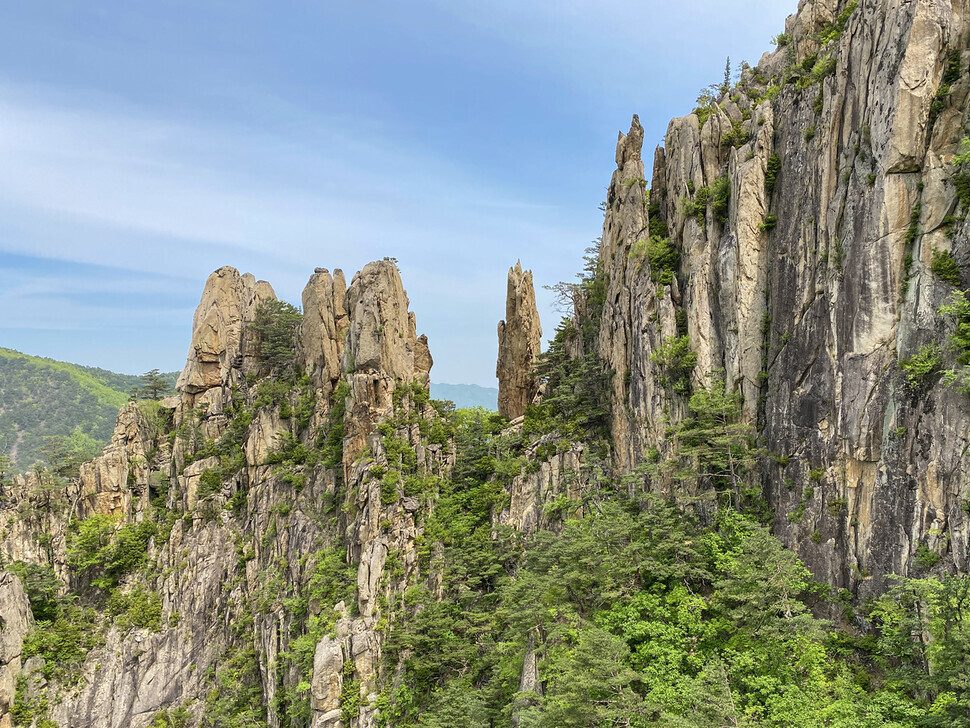
At the entrance to the valley is a massive rock slab, covering about 4,960 square meters, on which are engraved the poems of the greatest writers of their time, including Kim Si-seup (pen name Maewoldang).
Also popular are Beteul (Loom) Rock and the Beteul Rock Mountain Fortress Trail (7.3km, 5 hours). This trail offers a sweeping vista of Yongchu Waterfall, Sinseon (Taoist Immortal) Peak, Geumgangsan Rock, and Mount Duta Hyeopgok Macheonnu (Canyon Skyscraper), a section of trail that was opened to the public in June 2021.
Newbie hikers in the area may want to arrange a guide through the tourist information center at Mureung Valley, at the entrance to Mount Duta. That’s one of three tourist information centers in the Donghae city limits; the others are at Mukho waterfront park and Chuam Beach.
Travel information for Donghae is also available on the 1330 tourist hotline, which is available around the clock.
By Her Yun-hee, staff reporter
Please direct questions or comments to [english@hani.co.kr]

Editorial・opinion
![[Editorial] Intensifying US-China rivalry means Seoul must address uncertainty with Beijing sooner than later [Editorial] Intensifying US-China rivalry means Seoul must address uncertainty with Beijing sooner than later](https://flexible.img.hani.co.kr/flexible/normal/500/300/imgdb/original/2024/0517/8117159322045222.jpg) [Editorial] Intensifying US-China rivalry means Seoul must address uncertainty with Beijing sooner than later
[Editorial] Intensifying US-China rivalry means Seoul must address uncertainty with Beijing sooner than later![[Column] When ‘fairness’ means hate and violence [Column] When ‘fairness’ means hate and violence](https://flexible.img.hani.co.kr/flexible/normal/500/300/imgdb/original/2024/0516/7417158465908824.jpg) [Column] When ‘fairness’ means hate and violence
[Column] When ‘fairness’ means hate and violence- [Editorial] Yoon must stop abusing authority to shield himself from investigation
- [Column] US troop withdrawal from Korea could be the Acheson Line all over
- [Column] How to win back readers who’ve turned to YouTube for news
- [Column] Welcome to the president’s pity party
- [Editorial] Korea must respond firmly to Japan’s attempt to usurp Line
- [Editorial] Transfers of prosecutors investigating Korea’s first lady send chilling message
- [Column] Will Seoul’s ties with Moscow really recover on their own?
- [Column] Samsung’s ‘lost decade’ and Lee Jae-yong’s mismatched chopsticks
Most viewed articles
- 1[Editorial] Transfers of prosecutors investigating Korea’s first lady send chilling message
- 2[Exclusive] Unearthed memo suggests Gwangju Uprising missing may have been cremated
- 3Xi, Putin ‘oppose acts of military intimidation’ against N. Korea by US in joint statement
- 4S. Korea “monitoring developments” after report of secret Chinese police station in Seoul
- 5Truth commission confirms Korean War killings by soldiers and police
- 6[Editorial] South Korean women are mobilizing in unprecedented ways
- 7Calls for gender-equality continue as demonstrations target President Moon
- 8Why Kim Jong-un is scrapping the term ‘Day of the Sun’ and toning down fanfare for predecessors
- 9China calls US tariffs ‘madness,’ warns of full-on trade conflict
- 10[Column] US troop withdrawal from Korea could be the Acheson Line all over